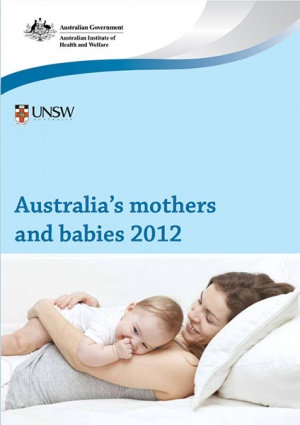Australia’s mothers and babies 2012
| Embryology - 3 May 2024 |
|---|
| Google Translate - select your language from the list shown below (this will open a new external page) |
|
العربية | català | 中文 | 中國傳統的 | français | Deutsche | עִברִית | हिंदी | bahasa Indonesia | italiano | 日本語 | 한국어 | မြန်မာ | Pilipino | Polskie | português | ਪੰਜਾਬੀ ਦੇ | Română | русский | Español | Swahili | Svensk | ไทย | Türkçe | اردو | ייִדיש | Tiếng Việt These external translations are automated and may not be accurate. (More? About Translations) |
Introduction
This data summarised below is provided to help you as a clinician or researcher understand the current trends in reproductive medicine within Australia.
The information is based upon data from the publication "Australia's mothers and babies 2012"[1] and is provided for educational purposes only. The original full publication is available online from AIHW Perinatal statistics series no. 69.
| Australia’s mothers and babies: 2017 | 2016 | 2015 | 2014 | 2013 | 2012 | 2011 | 2010 | 2009 | 2008 | 2007 | National Perinatal Statistics Unit | AIHW | Australian Statistics | birth |
Summary
In 2012, 307,474 women gave birth to 312,153 babies in Australia. This was an increase of 10,343 births (3.4%) from that reported in 2011, and a total increase of 21.5% since 2003. Nationally, the proportion of teenage mothers (younger than 20) declined from 3.7% in 2011 to 3.6% in 2011, compared with 4.6% in 2003.
Mothers
The average maternal age in 2012 was 30.1 compared with 29.5 in 2003.
Approximately 42% of women were having their first baby and the average age of first-time mothers was 28.4.
Of all first-time mothers in 2012, 14% were aged 35 or older compared with 12% in 2003.
Assisted reproductive technology (ART) was used by 4% of women who gave birth in the 5 jurisdictions for which data on ART were available.
Antenatal factors
Smoking while pregnant was reported by about 13% of all mothers and by 35% of teenage mothers.
About one-fifth (21%) of women who reported smoking during the first 20 weeks of pregnancy did not report smoking during the second 20 weeks. Over three-fifths (63%) of women attended at least 1 antenatal visit before 14 weeks gestation, although 15% of women did not receive antenatal care until after 20 weeks.
- Links: Smoking
Indigenous mothers
Overall, 4% of women who gave birth during 2012 identified as Aboriginal and/or Torres Strait Islander.
Indigenous mothers were younger than non-Indigenous mothers; their average age in 2012 was 25.2 compared with 30.3 for non-Indigenous mothers. Smoking during pregnancy was reported by almost half (48%) of Indigenous mothers. Of Aboriginal or Torres Strait Islander mothers who reported smoking during the first 20 weeks of pregnancy, 12% did not report smoking after 20 weeks, half that of non-Indigenous mothers (23%). One-quarter (25%) of Indigenous babies were born to mothers who identified as non-Indigenous.
Labour and delivery
The average duration of pregnancy was 38.7 weeks.
Onset of labour was spontaneous for 54% of women giving birth and induced for 26%.
Most women (68%) had a vaginal birth and, of these births, 82% did not involve the use of instruments.
Overall, 32% of women gave birth by caesarean section in 2012, similar to the proportion (32.3%) in 2011. The caesarean section rate among first-time mothers was 33% in 2012. Among women who had already given birth at least once, 29% had had a previous birth by caesarean section.
| Birth Links: birth | Lecture - Birth | caesarean | preterm birth | birth weight | macrosomia | Birth Statistics | Australian Birth Data | Developmental Origins of Health and Disease (DOHAD) | Neonatal Diagnosis | Apgar test | Guthrie test | neonatal | stillbirth and perinatal death | ICD-10 Perinatal Period | Category:Birth | ||
|
Baby outcomes
In 2012, 9% of babies were born pre-term (before 37 completed weeks of gestation) and 0.6% post-term (42 weeks gestation or more).
Overall, 6% of liveborn babies were of low birthweight (less than 2,500 grams) and this doubled (12%) among mothers who smoked during pregnancy. One in 5 (20%) babies received some form of resuscitation at birth, although almost half (49%) received only suction or oxygen therapy.
Perinatal deaths
The perinatal death rate was 9.6 per 1,000 births in 2012, with 7.2 fetal deaths per 1,000 births and 2.4 neonatal deaths per 1,000 live births.
This compares with 9.9 perinatal deaths per 1,000 births in 2011, 7.4 fetal deaths per 1,000 births and 2.6 neonatal deaths per 1,000 live births.
References
- ↑ Hilder L, Zhichao Z, Parker M, Jahan S, Chambers GM 2014. Australia’s mothers and babies 2012. Perinatal statistics series no. 30. Cat. no. PER 69. Canberra: AIHW. Viewed 16 December 2014. http://www.aihw.gov.au/publication-detail/?id=60129550033
Glossary Links
- Glossary: A | B | C | D | E | F | G | H | I | J | K | L | M | N | O | P | Q | R | S | T | U | V | W | X | Y | Z | Numbers | Symbols | Term Link
Cite this page: Hill, M.A. (2024, May 3) Embryology Australia’s mothers and babies 2012. Retrieved from https://embryology.med.unsw.edu.au/embryology/index.php/Australia%E2%80%99s_mothers_and_babies_2012
- © Dr Mark Hill 2024, UNSW Embryology ISBN: 978 0 7334 2609 4 - UNSW CRICOS Provider Code No. 00098G
